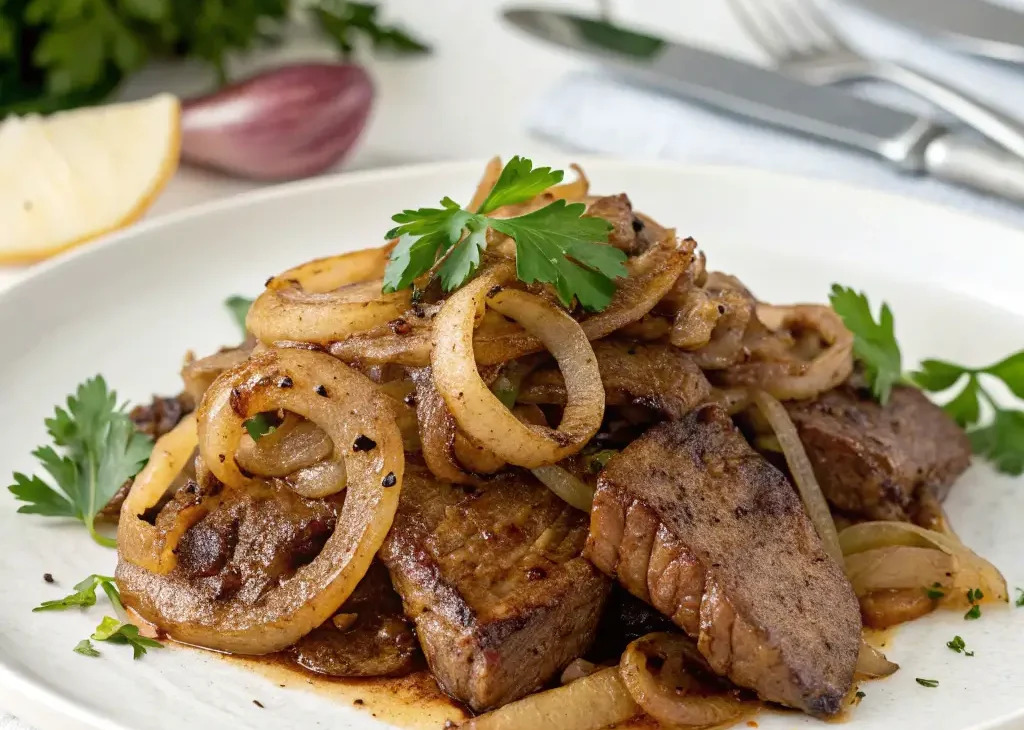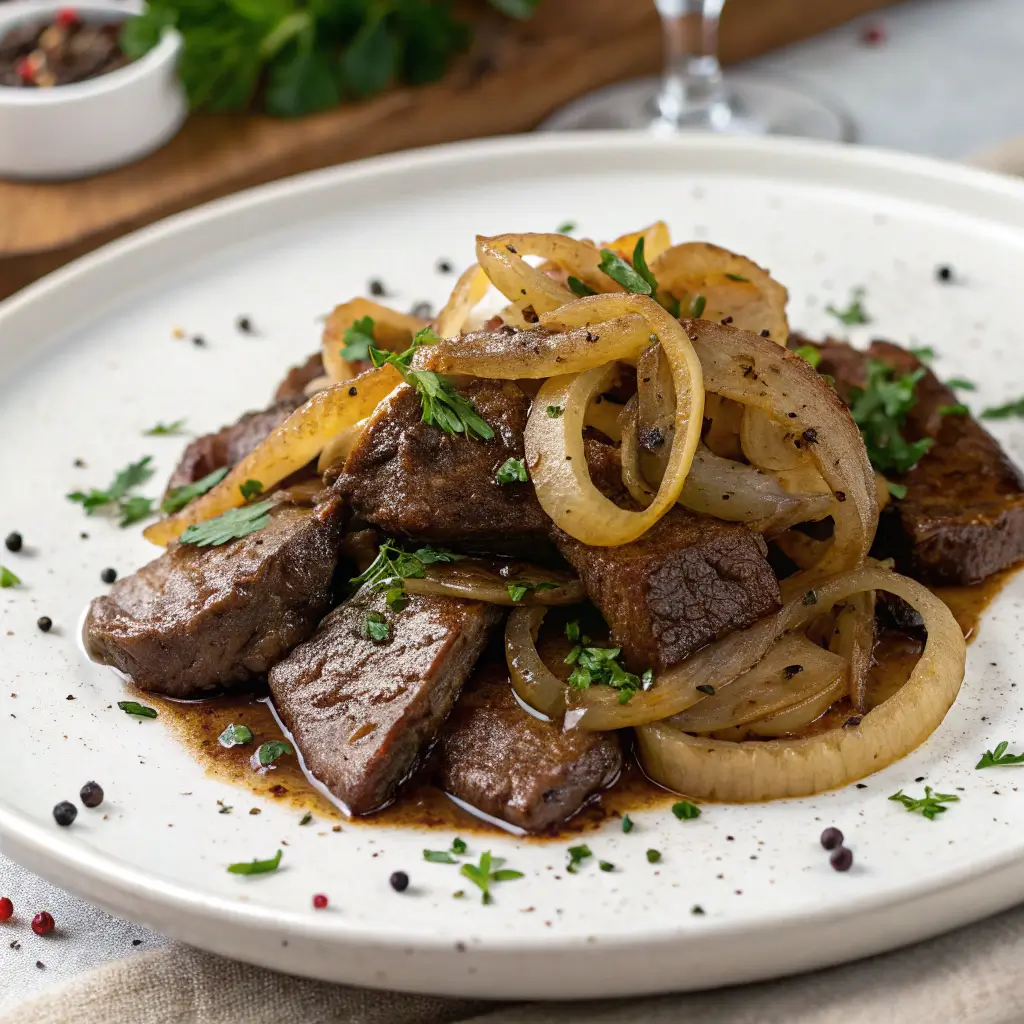Classic Beef Liver with Onions: A Nutrient-Dense Comfort Dish
The Ultimate Guide to Perfectly Cooked Liver
Beef liver with caramelized onions is a time-honored dish that combines exceptional nutrition with comforting flavors. When prepared correctly, this often-overlooked organ meat becomes a tender, flavorful delicacy that might just convert liver skeptics. Our methodical approach ensures you’ll achieve perfect texture and balanced flavors every time.
Why Liver Deserves a Place on Your Table
- Nutritional Superstar – Contains more nutrients per ounce than almost any other food
- Budget-Friendly Protein – Typically costs less than muscle meats
- Quick Cooking – Faster to prepare than most meats
- Versatile Base – Adaptable to various cuisines and flavor profiles

Selecting and Preparing Your Liver
Choosing Quality Liver
- Grass-fed sources offer superior flavor and nutrition
- Light color indicates younger, milder-tasting liver
- Smooth texture without spots or blemishes is ideal
- Fresh smell – should have a clean, metallic scent but not be overpowering
The Milk Soak Advantage
Soaking in milk serves three crucial purposes:
- Neutralizes bitterness by drawing out impurities
- Tenderizes the meat through enzymatic action
- Reduces strong odors for more approachable flavor
Pro Tip: For extra mildness, add 1 tbsp lemon juice or vinegar to the milk. The acidity helps further break down tough fibers while brightening the flavor profile.
Mastering the Onions
The caramelized onions are more than just a garnish – they’re an essential flavor counterpoint:
- Low-and-slow cooking develops natural sugars over 25-30 minutes
- Deglazing with broth captures all the flavorful browned bits (fond)
- Adding garlic and herbs at the end preserves their freshness
- Sugar addition accelerates caramelization without making onions overly sweet
Advanced Cooking Techniques
The Perfect Sear
- Pat liver completely dry before dredging – moisture is the enemy of good browning
- Use a cast iron skillet for even heat distribution and superior crust development
- Maintain high heat (about 375°F) to create flavorful Maillard reaction
- Don’t overcrowd the pan – leave space between pieces to prevent steaming
Doneness Indicators
- Medium-rare (ideal): Slightly pink center (145°F) – remains tender and juicy
- Medium: Light pink (160°F) – slightly firmer texture
- Well-done: Gray throughout (170°F+) – tends to be tough and dry
Creative Variations to Try
International Twists
- French Style: Add 2 tbsp brandy and 1/4 cup cream for a luxurious sauce
- Middle Eastern: Season with baharat spice mix and garnish with pomegranate seeds
- Asian-Inspired: Use sesame oil and ginger, finish with scallions
Dietary Adaptations
- Keto: Replace flour with crushed pork rinds or almond flour
- Paleo: Use arrowroot powder or tapioca starch instead of flour
- Dairy-Free: Substitute coconut milk or almond milk for soaking
Serving and Presentation Ideas
Plating Techniques
- Arrange liver slices in a fan shape for visual appeal
- Build onions into a tall center nest
- Garnish with fresh herbs like parsley or thyme sprigs
Complete Meal Ideas
- Classic Comfort: With buttery mashed potatoes and roasted carrots
- Modern Healthy: Over cauliflower puree with sautéed kale and mushrooms
- Bistro Style: Alongside frisée salad with warm bacon vinaigrette
- Rustic: Served on crusty bread with onion jam
Storage and Reheating Tips
Leftover Care
- Refrigerate for up to 3 days in airtight container
- Freeze for up to 1 month (texture may change slightly)
- Store onions separately if possible to maintain texture
Best Reheating Methods
- Skillet: Quick 1-minute sear per side to refresh crust
- Oven: 350°F wrapped in foil with 1 tbsp broth for moisture
- Avoid microwave – creates rubbery texture and uneven heating
Nutritional Breakdown (Detailed)
| Nutrient | Amount | % Daily Value | Health Benefits |
|---|---|---|---|
| Protein | 26g | 52% | Muscle repair and growth |
| Iron | 5mg | 28% | Oxygen transport, energy production |
| Vitamin A | 15,000 IU | 300% | Vision, immune function |
| B12 | 70mcg | 1,200% | Nerve function, red blood cell formation |
| Zinc | 4mg | 36% | Immune support, wound healing |
| Copper | 12mg | 600% | Iron metabolism, brain health |
| Riboflavin | 2.9mg | 223% | Energy production, skin health |
Based on 4oz serving with onions
Historical and Cultural Context
Liver with onions has been a staple dish across cultures for centuries due to:
- Nutritional necessity in traditional diets – provided vital nutrients missing from other foods
- Nose-to-tail butchery practices that valued all parts of the animal
- Affordability compared to muscle meats throughout history
- Medicinal uses – ancient physicians prescribed liver for various ailments
Different regional preparations include:

- Italian fegato alla Veneziana with white wine
- German leber mit zwiebeln often served with apples
- British liver and onions with gravy
- Southern U.S. style with bacon drippings
Modern Nutritional Perspectives
While liver fell out of favor in recent decades, nutritionists are now recognizing its incredible benefits:
- Bioavailable nutrients more easily absorbed than from supplements
- Sustainable choice aligns with nose-to-tail eating principles
- Cost-effective nutrition – provides more nutrients per dollar than most foods
- Supports local farmers when sourced from small producers
Current recommendations suggest:
- Limit to 1-2 servings per week for adults
- Pregnant women should limit due to high vitamin A
- Gout sufferers should consume in moderation.
Final Thoughts
This Beef Liver with Onions recipe demonstrates how proper technique can transform an intimidating ingredient into a delicious, nutrient-packed meal. The caramelized onions provide the perfect sweet contrast to the rich liver, while simple preparation keeps it approachable. Whether you’re eating liver for health benefits or nostalgic comfort, this dish delivers maximum flavor with minimal effort.
Happy cooking and nourishing your body! 🥩🧅🌿

